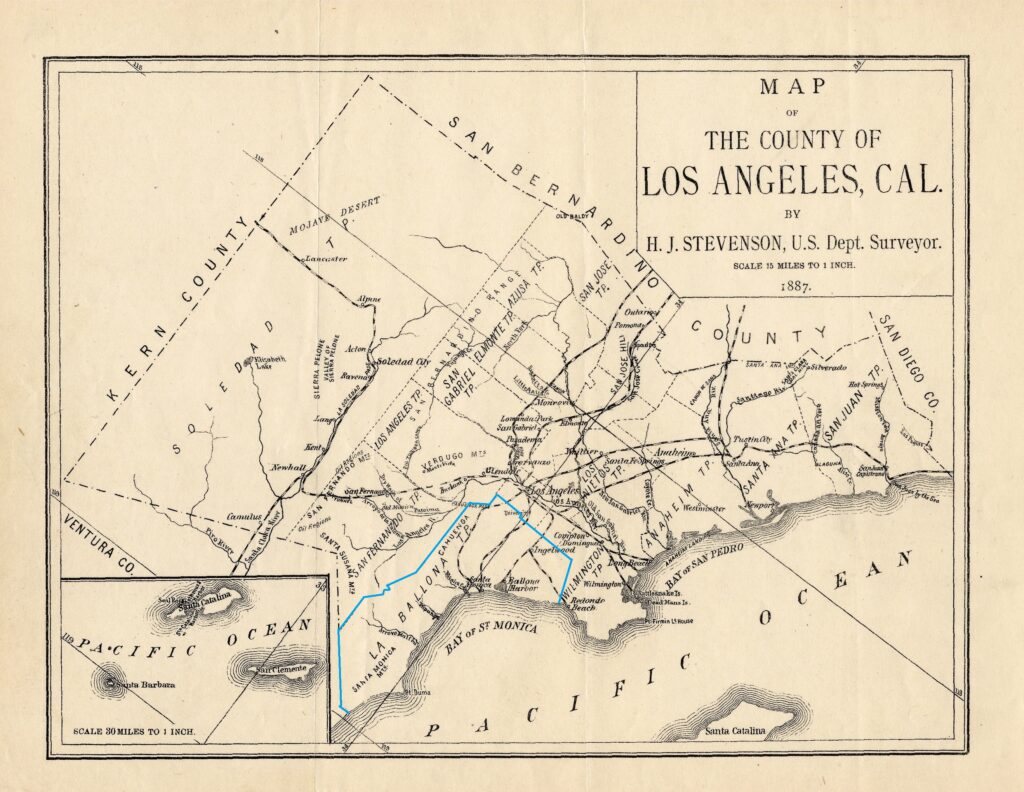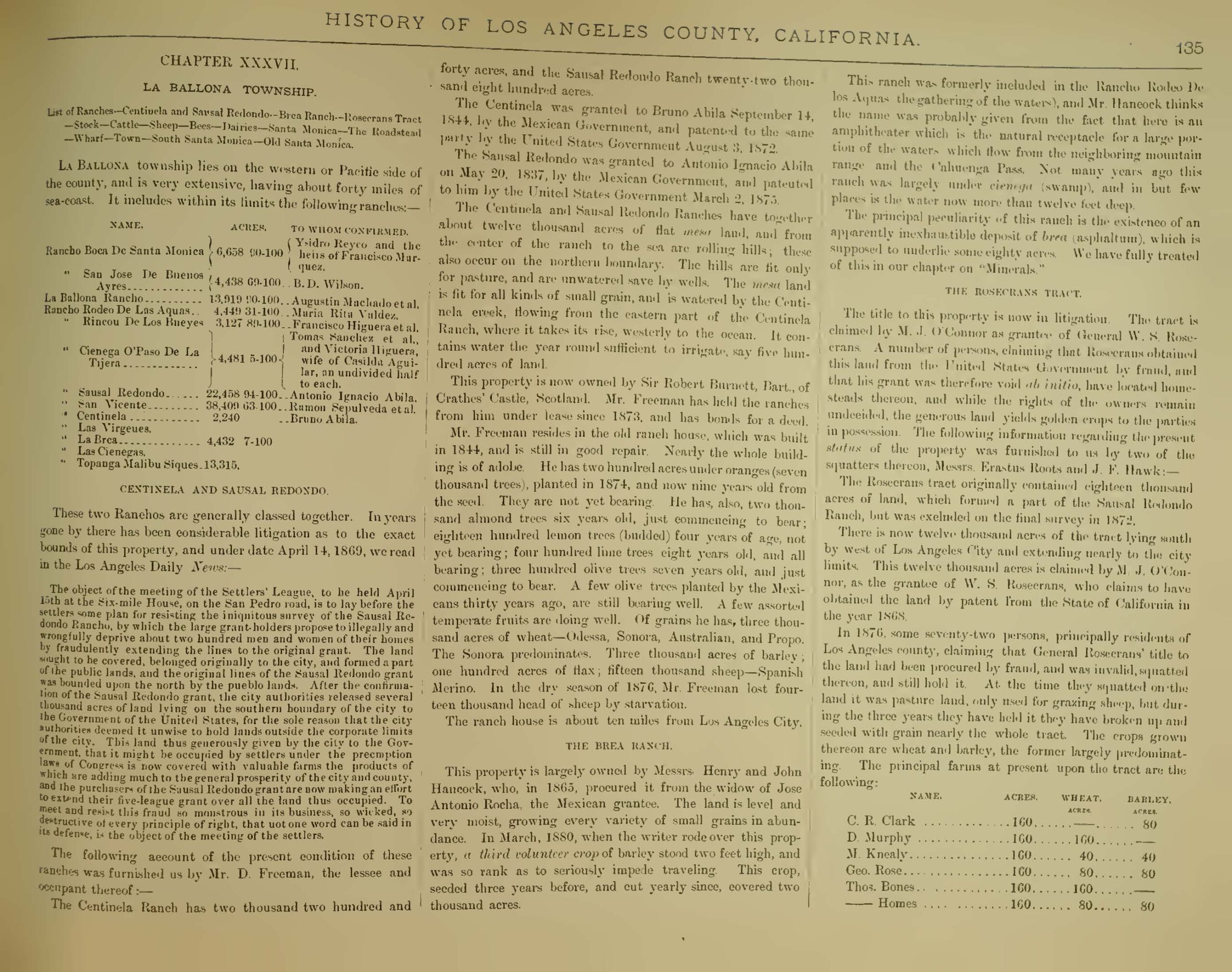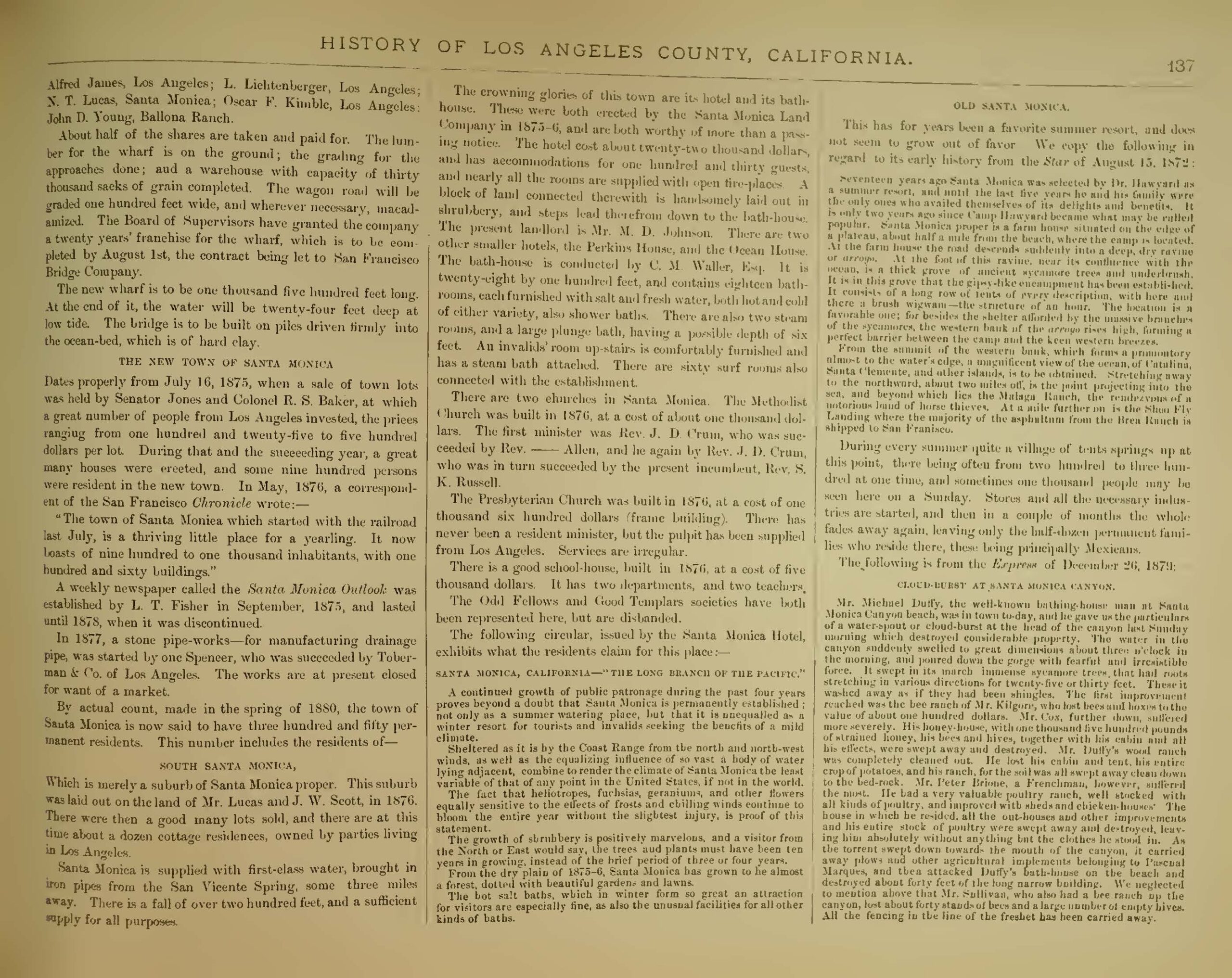La Ballona Township was a judicial district established in the 19th century as part of Los Angeles County’s early administrative organization. It served as an electoral and judicial unit encompassing areas that now include Santa Monica, Venice, and The Palms. This page outlines its formation, boundaries, and eventual dissolution.
California’s Counties Established (1850)
Even before California was granted statehood (on September 9, 1850), it had a constitution. The final draft was adopted on October 13, 1849, and ratified by public vote on November 13, 1849. It provided for the creation of local governments: “the Legislature shall establish a system of county and town governments, which shall be as nearly uniform as practicable throughout the State.” (Constitution of 1849, art. XI, § 4.) As authorized, on February 18, 1850, the Legislature divided California into twenty-seven counties.

Initially, Los Angeles County ran from the Pacific Ocean to the Nevada state line. At 34,520 square miles, it was larger than eleven of the states of the union. (The largest of the eleven, South Carolina, covers 32,020 square miles). It grew smaller over the years. In 1853, San Bernardino County was carved from the eastern part. In 1866, territory to the north was joined with land from Tulare County to form Kern County. In 1881, the boundary between Los Angeles and Ventura County was resurveyed, resulting in an additional 300 square miles going Ventura County. Finally, Orange County was cleaved from Los Angeles County in 1886.
Los Angeles County’s first Townships (1851)
On August 7, 1851, Los Angeles County was divided into six townships: Los Angeles (which included the San Fernando Valley), San Gabriel, San Jose (encompassing today’s cities of Pomona, Claremont and Walnut), San Bernardino, Santa Ana, and San Juan Capistrano.
Under date August 7, 1851, the following order appears in the minute of the Court of Sessions, now on file in the County Clerk’s office:—
(History of Los Angeles County California (Thompson & West, Oakland, 1880), p. 48, shown below.)
Ordered—That the county of Los Angeles be divided into six townships, named as follows, and to comprehend the ranchos and places as follows, to each appropriated:—
TOWN OF LOS ANGELES.
The city of Los Angeles and the following ranchos, to wit:—
Los Corralitos; Feliz; Verdugos; Cahuenga; Tujunga; San Fernando, ex-Mission; San Francisco; Piro; Camulos; Canada de los Alamos; La Liebre; El Tejon; Triumfo; Vergeues; Escorpion; Los Cuervos; San Antonio de la Mesa; Los Alamitos; Vincente Lugo; Arroyo Seco; Encino; Maligo; Santa Monica; San Vicente; Buenos Ayres; La Bayona; Rincon de los Bois [Bueyes]; Rodeo de los Aguas; La Cienega; La Centinela; Sausal Redondo; Palos Verdes; San Pedro; Los Dominguez; Rancho Nuevo; Paredon Blanco; Los Serritos; La Yaboueria; Rosa de Castilla
The residence of the authorities shall be in Los Angeles City.
TOWN OF SAN GABRIEL.
The mission of the same name, and the ranchos of San Pasqual, Santa Anita, Andres Duarte, Azusa, La Puente, Los Coyotes, Nietos with all its lines of boundary, Cienega, Mission Vieja with all its lines of boundary.
The residence of the authorities is in San Gabriel.
TOWN OF SAN JOSE.
Cucamonga, San Antonio, San Jose, El Pedregoso, San Jose en Medio, Los Nogales, Rancho de los Ybarra.
The residence of Justices is in San Jose en Medio.
TOWN OF SAN BERNARDINO.
Rancho del Chino, Guapa, Jurupa within all its boundaries, Agua Mansa within all its boundaries, San Bernardino, Yucaypa, San Gorgoneo.
The residence of Justice is Jurupa.
TOWN OF SANTA ANA.
Las Bolsas, Los Paredes, Ranchito Mamado de Polieaipo, Santiago, Santa Ana Abajo, Santa Ana en Medio, San Antonio de Don Bernardino Yorba, El Temescal, La Lierra el Rincon, Rancho de Juan P. Ontiveras (Aguage).
The residence of Justice shall be at the San Antonio de Don Bernardino Yorba.
TOWN OF SAN JUAN CAPISTRANO.
San Mateo, Mission Vieja, El Trabuco, San Juan Capistrano all its population, Los Alisos, San Joaquin.

California’s “townships” differed markedly from the rectangular survey townships of the Midwest and the robust township governments of New England. In contrast, California townships held limited authority — and their powers were further curtailed by the California constitution of 1879. From that point forward, their primary functions were to define judicial jurisdictions, organize election precincts, and facilitate federal census enumeration. Civic scholar John Richard Sutton (1870-1956) explained:
A judicial township is not a public corporation; it owns no property and collects no tax. It is an election district for choosing justices of the peace and constables. The salaries of these officers are paid by the county except where they are permitted to retain the fees which they collect. The township limits territorially the civil jurisdiction of the justice’s court, but its criminal jurisdiction extends throughout the county. Townships include cities, or parts of cities, as well as country districts, so that every portion of the state is located in some township. This is true even of San Francisco, which is really a township, as well as a city and county.
(Civil Government in California (American Book Company, 1914).)
The 1860 census reported Los Angeles Township’s population was 1,231, and the 1870 census reported a population of 2,757 – both enumerations excluded the City of Los Angeles which counted 4,385 and 5,708 people, respectively. (The Branding Iron, Los Angeles Westerners Corral, Fall 2007.)
La Ballona Township Formed (c. 1880)
By 1880, the Los Angeles County Supervisors had broken up Los Angeles Township and established La Ballona Township, along with Anaheim, Azusa, El Monte, Fountain Valley, Los Nietos, Santa Ana, San Antonio, San Fernando, San Gabriel, San Jose, San Juan, Silverado, Soledad, Westminster, and Wilmington townships. (Los Angeles Evening Express, Oct. 22, 1880.) (Orange County had not yet been separated from Los Angeles County.)

A 1947 Evening Vanguard newspaper article (possibly written by Palms historian David Worsfold (1907-1975)) described La Ballona Township’s early development and outlined its borders:
(August 19, 1947, Evening Vanguard.)
The first development of the valley began when Sen. John P. Jones of Nevada subdivided the town or Santa Monica in 1875. Jones also built the area’s first
railroad. The Los Angeles and Independence, which runs through the local community along Exposition Blvd. and today is known as the Pacific Electric Air Line.
The second community development in the valley was a subdivision known as “The Palms,” recorded in 1886 on 500 acres of the former Rancho La Ballona. Next came Hollywood in 1887, and Barrett Villa was platted in 1896. This became Sawtelle and later was changed to West Los Angeles.
The former Ballona Township boundaries (described by present day place names) are roughly as follows: from Griffith Park to the University of Southern California, thence to Redondo Beach, thence along the coast to the county line west of Santa Monica and east along the summit of Santa Monica Mountains to Griffith Park.
Although La Ballona Township was large, its population was not. Mr. Worsfold was quoted about this in a 1964 newspaper article:
Back in 1880, the census for the whole area west of Hoover Street – the Los Angeles boundary at that time – listed exactly 417 inhabitants.
(June 21, 1964, Evening Vanguard.)
“In 1880 … Ballona Township was a great area extending from the summit of the Santa Monicas Mountains to the Palos Verdes Hills, then to Exposition Park and north along Hoover Street.”
“There was a settlement, railroad station and post office called Machado where Palms is now located. But the village of Santa Monica had most of the people – the rest were scattered on ranches and farms.
“Ballona Township had more animals than people for sure. There were 30,000 head of sheep, 2,000 beef cattle and 300 dairy cows.”
John Albert Wilson’s 1880 History of Los Angeles County California profiled La Ballona Township – including the numbers of sheep cattle and dairy cows that Worsfold referenced. (Click here for a transcript).



La Ballona Township Renamed Venice Township (1916)
In 1915, Los Angeles County Supervisors considered renaming La Ballona Township to Venice Township.
The change in name from “Ballona” township to “Venice” township is one of the changes that has long been desired. Information received from Supervisor W. E. Hinshaw and County Counsel Hill is to the effect that the much-desired change will be made. “Ballona” is an old Spanish name that has become confusing to many of the new-comers. Besides, Venice is the principal city in the township, the court located here, and, in the very nature of things, the township should be named “Venice.” The change will probably become effective on or about January 1, 1916.
(December 7, 1915, Evening Vanguard.)
The newspaper reported official notice of the name change from La Ballona Township to Venice Township on January 8, 1916 – marking the end of La Ballona Township. At the time, Venice was an independent city, incorporated in 1905. In 1926, Venice was annexed into the City of Los Angeles.
The Justices’ Court of Venice Township operated until July 1, 1947, when its name was changed to the Justices’ Court of Culver Township. According to the ordinance implementing the change, the latter would “continue to be the successor of the Justices’ Courts of Venice Township, Talamantes Township, Arnaz Township, and Chavez Township.” (Those other townships had been consolidated into Venice Township in 1934.) Supporters of the name pointed out that “Venice Township is a misnomer, since Venice is not in the township and is served by Los Angeles municipal courts. (May 1, 1947, Evening Vanguard.) The Culver Township Justice Court was apparently supplanted by the Culver City Municipal Court in 1956. (Aug. 6, 1956, Evening Vanguard.)